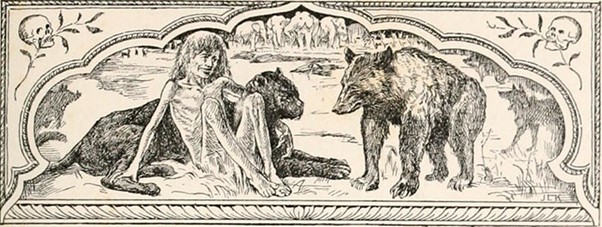Challenge 4
Dear Volunteers,
Your research brought you to the jungle. Welcome! But be careful, jungle animals can be dangerous if you don’t know much about them. Come, let’s learn a bit more, so you will be safe. Here’s a guide to the animals in The Jungle Book:
Keep your friends close and the jungle animals closer. Get to know the animals. Read their introductions and find out their names with the help of the article. Their names will open the locks. Have a great experience in the Jungle!
Now you know a lot about animals. But what about humans? Do they live in the jungle? Read the the text below and decide which of the statements in italics are True, False or Not Given. You don't have to understand all words to find out the answers.
Meet the Real-Life Mowgli, The Boy Who In 1892 Was Found Living in Jungle
Julija Svidraitė
BoredPanda staff
There probably isn’t a single person who hasn’t heard about the legendary Mowgli from Rudyard Kipling’s famous work, The Jungle Book. Yet many folks have no idea that this book was inspired by a real-life story.
Meet Dina Sanichar, or “the Indian wolf-boy,” a feral boy who lived in the 19th century and was raised by wolves—many believe that Dina was the real inspiration behind The Jungle Book, though it’s worth noting that the actual story isn’t as fun as the one we’re used to. In reality, it’s much more tragic than that…

Image credits: Wikimedia Commons
In fact, Dina was one of many feral children found in India over the years. Turns out, the country has a long history of children raised by all kinds of animals, such as panthers, dogs, and even chickens.
In 1872, Dina Sanichar was discovered by a group of hunters in Uttar Pradesh. The boy was walking on all fours and was following a pack of wolves.
After that, the boy, along with his companions, retreated into a den. This whole sight was both intriguing and absolutely terrifying to the hunters. Since the mysterious boy piqued their interest, the crew was determined to get their hands on him. First of all, the hunters attempted to get them out of the cave by setting it on fire. When the wolves and the boy finally came out, the hunters killed the wolves and took the boy with them.
The boy was believed to be six years old.
The hunters brought the boy to an orphanage where he was baptized and given the name Sanichar, which means “Saturday” in Urdu because that’s the day he arrived at the orphanage.
1 Literary historians believe that Dina Sanichar was the inspiration behind the Jungle Book.
2 A group of hunters found the boy in India, in 1972.
3 He was wearing no clothes when the hunters discovered him.
4 Dina was named after the day he arrived at his new home.
Sanichar struggled a lot. The boy was considered to have a really low IQ: father Erhardt, who was the head of the orphanage, noted that though the boy was “undoubtedly pagal (imbecile or idiotic), [he] still shows signs of reason and sometimes actual shrewdness.” Besides, he never learnt how to speak. At the orphanage, many tried to teach him to do so, but he never managed to learn how to speak, read, or write.
The boy communicated by making animal noises and continued to walk on all fours.
Even though eventually Sanichar learned to walk on two legs, he still struggled with wearing clothes and preferred to be naked.
Besides, when he first arrived at the orphanage, he refused to eat cooked meals and would sharpen his teeth on bones.
But despite showing almost no human traits, he managed to make a human friend. Apparently, in the orphanage, there was another feral child who also grew up with animals. Since both boys grew up in wildlife, they had a difficult time relating to humans and that probably was the reason why they managed to form this distinct bond between one another. Father Erhardt noted that “a strange bond of sympathy attached these two boys together, and the elder one first taught the younger to drink out of a cup.”
5 Father Erhardt taught him basic social skills, without permanent effect.
6 Sanichar never managed to learn how to speak.
7 Sanichar could walk on two legs.
One of few humanly habits Sanichar integrated into his own life was smoking!
Many believe that smoking was what later led him to develop tuberculosis.
Dina’s development was overall abnormal: even after 10 years of living among humans, he was very anxious and jumpy, barely five feet tall, had very large teeth and a low forehead. Having spent most of his childhood with wolves, he must have felt like a confused alien, forcefully separated from his own home.
Dina passed away in 1895 from tuberculosis. He was just 29 years old.
As we mentioned before, there were many accounts of feral children raised by animals found in India over the years.
Around the time of Dina’s discovery, four other feral wolf children were also reported in India, and over the years, there were many more of these cases.
One of the most famous cases involved two girls named Amala and Kamala. Reportedly, these girls were rescued from a pack of wolves in India in the 1920s. The man who found them was named J.A.L. Singh and he claimed that they howled at the moon, walked on four legs, and only ate raw meat.
There are many more stories like that out there, but many of them were later debunked. So, I guess, we’ll never know.
These stories about feral children raised by animals have inspired many writers and poets.
One such artist was Rudyard Kipling, who wrote the famous book about Mowgli called The Jungle Book. The author never explicitly claimed that his Mowgli character was based on Dina Sanichar, although the part in which the character was conceived portrays the way Dina was taken care of. Besides, the timeline aligns quite perfectly, since the book was published approximately 20 years after the discovery of the boy.
Unlike Mowgli, Dina didn’t leave the jungle willingly and was rather forced back into human society.
Even though he was forcefully brought back to society, he never managed to meet the expectations of those around him. After spending the first 6 years of his life living in the jungle, it was simply impossible for him to rewire his brain and turn into a real human being. So, for the rest of his life, he continued to be this fascinatingly tragic being he had been conditioned to be.
In a way, Dina was bound to psychologically and developmentally stay in the jungle for the rest of his life.
8 Dina was the only savage child in the state.
9 During his socialization he learnt how to smoke, which led him to death about twenty years later.
10 According to the author, Dina Sanichar was meant to stay in the wilderness all his life.
Send the information to our department.
Copyright 2019. All rights reserved

